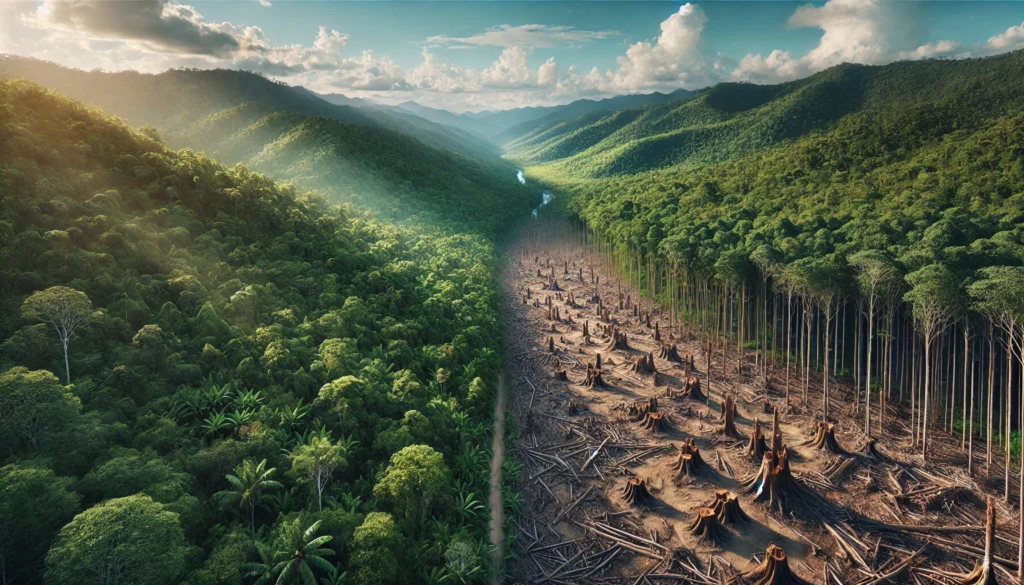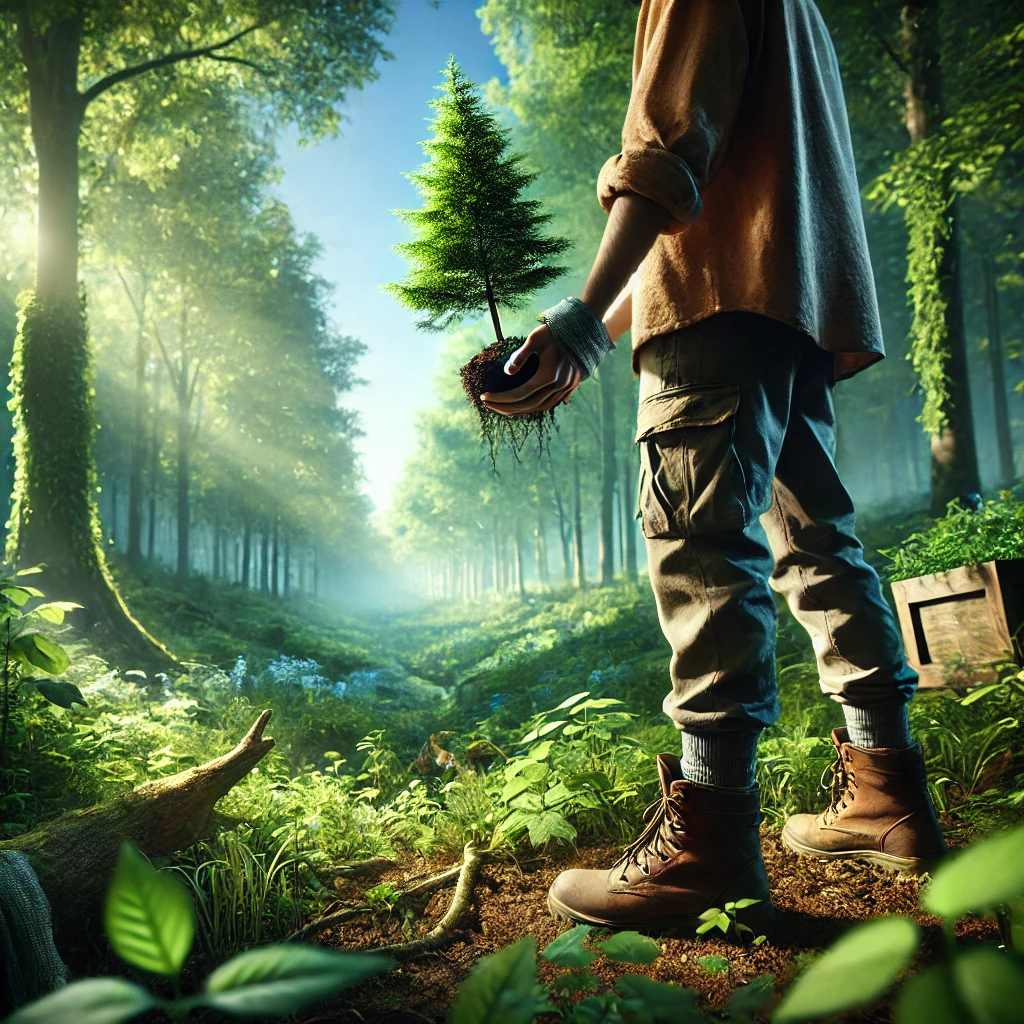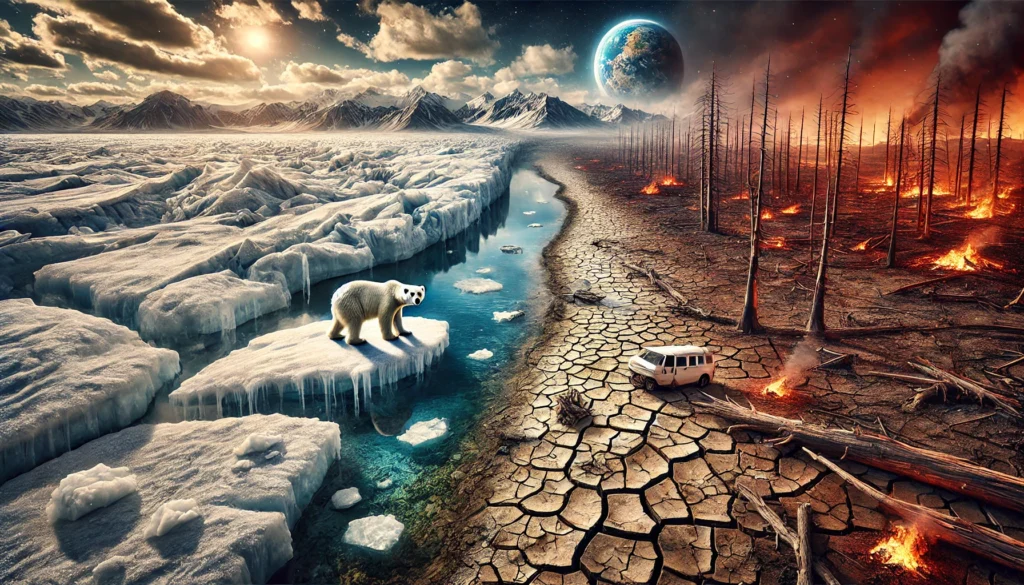Hey there, nature lovers and tree huggers! Today, we’re diving into a topic that’s hotter than a Filipino summer – deforestation in the Philippines. Grab your imaginary machetes and put on your virtual hiking boots, because we’re about to trek through the disappearing forests of this beautiful archipelago. Don’t worry; I promise to keep things light and breezy, even though we’re talking about a pretty heavy subject. So, let’s get ready to explore the causes and consequences of deforestation in the Philippines, shall we?
The Vanishing Act: A Brief Overview of Philippine Forests
Picture this: you’re in a time machine, traveling back to the early 1900s. You land in the Philippines, and what do you see? Trees. Lots and lots of trees. In fact, about 70% of the country was covered in lush, green forests. Fast forward to today, and you’d be forgiven for thinking someone played a massive game of “hide the forest.” Because, folks, those trees have pulled quite the disappearing act.
Let’s break it down with some numbers, shall we? Brace yourselves; this table might make you want to hug the nearest tree:
| Year | Forest Cover (%) |
|---|---|
| 1900 | 70% |
| 1950 | 50% |
| 1990 | 20.7% |
| 2010 | 23% |
| 2020 | 27.2% |
Now, I know what you’re thinking: “Wait a minute! Those last two numbers are going up!” And you’d be right, eagle eyes! There’s been a slight increase in forest cover in recent years, thanks to reforestation efforts. But before we start popping champagne corks, let’s remember that we’re still a long way from those glory days of 70% coverage. It’s like losing 100 pounds and then gaining back 10 – better than nothing, but you’re not exactly back to your fighting weight.
The Culprits: Why Are Philippine Forests Disappearing?
Alright, folks, it’s time to play detective. Who or what is behind this great forest vanishing act? Spoiler alert: it’s not a magician with a really big hat. Let’s meet our lineup of usual suspects:
1. Logging: The Woody Nemesis
Ah, logging. It’s like a bad breakup for trees – sudden, devastating, and leaves a lot of debris behind. Legal and illegal logging have been major players in the deforestation game. Picture burly lumberjacks with chainsaws, except sometimes these lumberjacks are more like sneaky ninjas operating in the dead of night.
The Philippine government has tried to put the brakes on logging, implementing bans and regulations faster than you can say “timber!” But enforcing these rules in remote areas? Well, that’s about as easy as trying to herd cats. Spoiler: cats don’t herd well.
2. Agriculture: From Forest to Farm
Remember that time you cleared out your closet to make room for more shoes? Well, imagine doing that on a massive scale, except instead of shoes, it’s crops and livestock. As the population grows, so does the need for food. And where do we get that food? From farms, of course! The problem is, those farms are often carved right out of forested areas.
Slash-and-burn agriculture, or “kaingin” as it’s known locally, has been a particular thorn in the side of Philippine forests. It’s like a really destructive game of musical chairs, where farmers clear a patch of forest, farm it until the soil is depleted, and then move on to the next patch. Rinse and repeat, and voila – you’ve got yourself some serious deforestation.
3. Mining: Digging for Trouble
If logging is like a bad breakup for forests, then mining is like a category 5 hurricane. It doesn’t just remove trees; it can change entire landscapes. The Philippines is rich in mineral resources, which is great for the economy but not so great for the forests.
Mining operations often require clearing large areas of forest. And let’s not forget the roads and infrastructure needed to support these operations. It’s like throwing a house party and inviting not just your friends, but also their friends, their pets, and their pet’s friends. Before you know it, your neat little forest “house” is trashed.
4. Urban Expansion: Concrete Jungle Fever
As cities grow, they tend to eat up surrounding areas like a giant game of Pac-Man. And guess what’s often in those surrounding areas? You guessed it – forests! Urban expansion is like the ultimate forest makeover show, except instead of a fabulous new look, the forest gets replaced by buildings, roads, and parking lots.
The Philippines has seen rapid urbanization in recent decades. Manila, the capital, has sprawled outwards, gobbling up former forest lands faster than you can say “urban planning.” It’s like watching a time-lapse video of a forest being replaced by a city, except it’s happening in real-time and there’s no “undo” button.
The Fallout: Consequences of Deforestation
Now that we’ve met the culprits, it’s time to look at the crime scene. What happens when you take away a significant chunk of a country’s forests? Spoiler alert: it’s not pretty. Let’s break down the consequences:
1. Biodiversity Loss: Bye-Bye, Unique Critters
The Philippines is what scientists call a “biodiversity hotspot.” No, that doesn’t mean it’s a trendy nightclub for animals. It means it’s home to a vast array of unique plant and animal species. Or at least, it was. Deforestation is like the world’s worst eviction notice for these creatures.
Let’s look at some numbers:
| Species Group | Number of Threatened Species (as of 2020) |
|---|---|
| Mammals | 38 |
| Birds | 96 |
| Reptiles | 39 |
| Amphibians | 74 |
| Fishes | 85 |
| Plants | 254 |
Each of these species is like a unique book in the library of life. And deforestation? It’s like a really careless librarian setting fire to the rare books section. Once these species are gone, they’re gone for good. No reprints, no second editions.
2. Climate Change: Turning Up the Heat
Trees are nature’s air conditioners. They absorb carbon dioxide and release oxygen, helping to keep our planet cool. Cut down those trees, and suddenly Earth starts running a fever. It’s like removing all the ice from your drink on a hot day – things are going to warm up fast.
Deforestation in the Philippines contributes to global climate change, but it also has local effects. Less forest cover means less rainfall, higher temperatures, and more extreme weather events. It’s like Mother Nature decided to crank up the thermostat and leave the fan off – uncomfortable for everyone involved.
3. Soil Erosion: When the Ground Beneath Your Feet Disappears
Trees aren’t just pretty to look at; their roots help hold the soil in place. Remove those trees, and suddenly the soil decides it wants to travel. This leads to erosion, landslides, and sedimentation of rivers and coastal areas. It’s like nature’s version of a slip-and-slide, except a lot less fun and a lot more destructive.
In the Philippines, this has led to increased flooding, damage to agricultural lands, and even impacts on coral reefs as sediment washes into the sea. It’s a domino effect that starts in the forest and ends up affecting everything downstream – literally.
4. Economic Impact: When Short-Term Gain Leads to Long-Term Pain
Sure, logging, mining, and agriculture bring in the bucks in the short term. But what about the long-term costs? Loss of ecosystem services, increased disaster risk, and impacts on industries like ecotourism can add up to a hefty bill.
Here’s a quick look at some of the economic impacts:
| Impact | Estimated Annual Cost (USD) |
|---|---|
| Soil erosion in agricultural areas | 100 million |
| Flood damage | 200 million |
| Loss of potential ecotourism revenue | 50 million |
These numbers are just the tip of the iceberg. It’s like maxing out your credit card for a big party, only to wake up the next day with a massive hangover and an even bigger bill. Except in this case, the hangover lasts for generations.
Fighting Back: Efforts to Combat Deforestation
Alright, enough doom and gloom. Let’s talk about the good stuff – the efforts being made to turn this ship around. Because believe it or not, there are people out there who actually like trees and want to keep them around. Shocking, I know!
1. Government Initiatives: Policies with Punch
The Philippine government hasn’t been sitting on its hands while the forests disappear. They’ve been busy cooking up policies and programs faster than you can say “reforestation.” Here are a few of the heavy hitters:
- National Greening Program (NGP): Launched in 2011, this ambitious program aimed to plant 1.5 billion trees covering 1.5 million hectares by 2016. It’s like a nationwide tree-planting party, and everyone’s invited!
- Forest Management Program: This focuses on sustainable forest management and community-based approaches. It’s like giving local communities the keys to the forest and saying, “Here, you take care of it.”
- Logging Bans: Various logging bans have been implemented over the years, including a total log ban in natural forests in 2011. It’s the government’s way of saying, “Hands off our trees, buddy!”
While these initiatives sound great on paper, implementation and enforcement remain challenging. It’s like having a really great recipe but struggling with the actual cooking part.
2. NGOs and Community Efforts: Grassroots for the Win
Where government efforts fall short, NGOs and local communities often step in. Organizations like Haribon Foundation and the Environmental Science for Social Change (ESSC) have been working tirelessly to protect and restore Philippine forests.
These groups often work directly with local communities, implementing reforestation projects, sustainable livelihood programs, and environmental education initiatives. It’s like a forest protection dream team, with everyone from scientists to local farmers playing their part.
3. International Support: A Global Village Saves a Forest
The Philippines isn’t fighting this battle alone. International organizations like the United Nations Development Programme (UNDP) and the World Bank have provided support for various forest conservation and sustainable development projects.
For example, the Forest and Climate Protection Panay Phase II project, supported by the German government, aims to protect and sustainably manage the forests of Panay Island. It’s like having a really supportive friend who not only cheers you on but also rolls up their sleeves to help.
The Road Ahead: Challenges and Opportunities
So, where do we go from here? Is there hope for Philippine forests, or should we start saying our goodbyes now? Well, hold onto your hats, folks, because the future is a mixed bag of challenges and opportunities.
Challenges: The Uphill Battle
- Population Growth: More people means more demand for land and resources. It’s like trying to fit more and more people into a shrinking house – something’s gotta give.
- Climate Change: As the planet warms, forests face new threats like increased fire risk and changing rainfall patterns. It’s like playing a game where the rules keep changing, and the difficulty level keeps going up.
- Enforcement of Laws: Having great forest protection laws is one thing; enforcing them is another. It’s like having a “No Littering” sign in a park – it only works if people actually follow the rules (or face consequences if they don’t).
- Balancing Development and Conservation: The Philippines, like many developing countries, faces the challenge of economic growth versus environmental protection. It’s the ultimate balancing act, like trying to juggle chainsaws while riding a unicycle.
Opportunities: Reasons for Hope
- Increasing Environmental Awareness: More Filipinos are becoming aware of environmental issues and the importance of forests. It’s like the whole country is slowly waking up to a giant, collective green alarm clock.
- Sustainable Development Goals: The Philippines has committed to the UN’s Sustainable Development Goals, which include targets for forest conservation. It’s like joining a global gym membership for the planet – now they just need to show up and do the work.
- Technological Advancements: New technologies are making forest monitoring and protection easier. Think satellite imaging, drones, and AI. It’s like giving forest rangers superpowers – “With great technology comes great responsibility to protect trees!”
- Eco-Tourism Potential: The Philippines has enormous potential for eco-tourism, which can provide economic incentives for forest conservation. It’s like realizing your old comic book collection is actually worth a fortune – suddenly, those trees look a lot more valuable standing up than chopped down.
The Final Leaf
As we come to the end of our journey through the forests (or what’s left of them) of the Philippines, what have we learned? Well, for one, deforestation is a complex issue with no easy solutions. It’s like trying to solve a Rubik’s cube blindfolded while riding a rollercoaster – challenging, to say the least.
But here’s the thing: it’s not all doom and gloom. Yes, the Philippines has lost a significant portion of its forests. Yes, the consequences are serious and far-reaching. But there’s also hope. From government initiatives to grassroots movements, from international support to technological innovations, people are fighting back.
The future of Philippine forests depends on a delicate balance of economic development, environmental conservation, and social equity. It’s going to take effort, innovation, and probably a fair bit of stubbornness to turn things around. But hey, if there’s one thing Filipinos are known for, it’s resilience in the face of challenges.
So, the next time you see a tree, give it a little nod of appreciation. Better yet, plant one if you can. Because in the end, the fate of Philippine forests – and indeed, forests around the world – is in our hands. And that, my friends, is no laughing matter.
Disclaimer: This blog post is based on data and information available up to 2020. While we strive for accuracy, the dynamic nature of environmental issues means that some information may have changed since then. If you spot any inaccuracies, please let us know so we can update our information faster than a logger can say “timber!”




